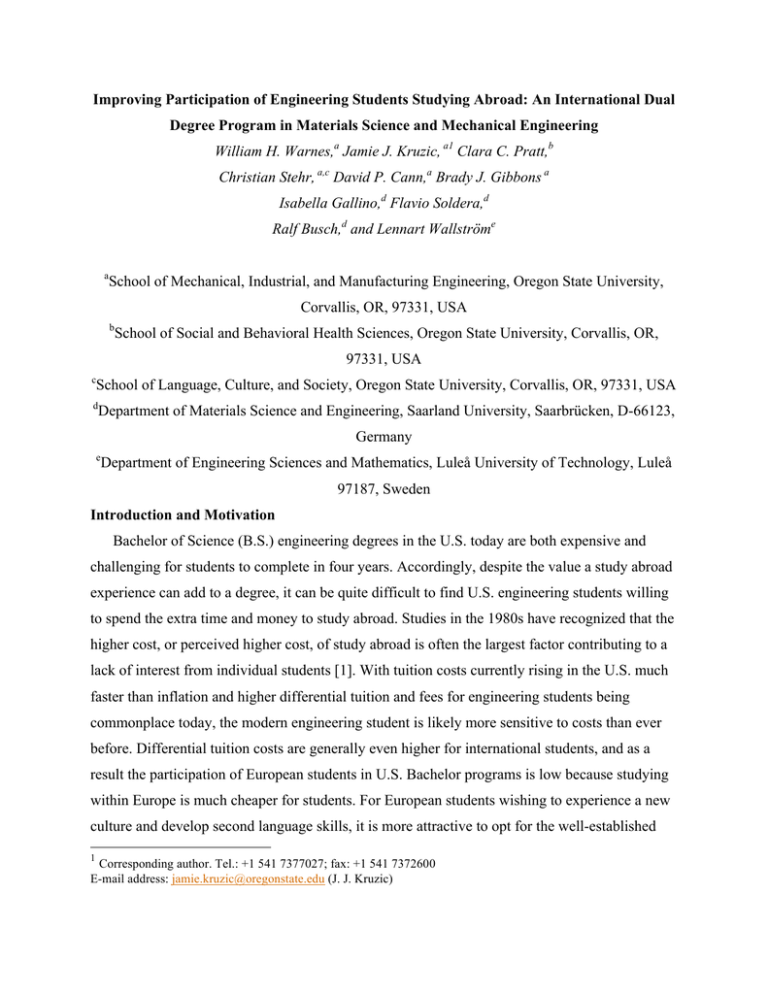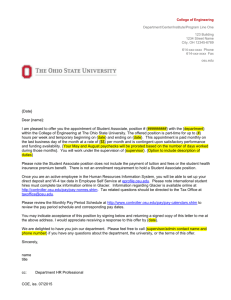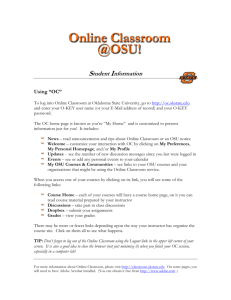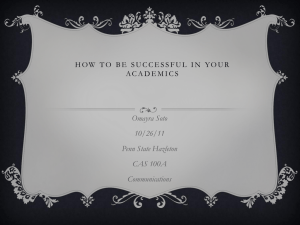Improving Participation of Engineering Students Studying Abroad: An International Dual
advertisement

Improving Participation of Engineering Students Studying Abroad: An International Dual Degree Program in Materials Science and Mechanical Engineering William H. Warnes,a Jamie J. Kruzic, a1 Clara C. Pratt,b Christian Stehr, a,c David P. Cann,a Brady J. Gibbons a Isabella Gallino,d Flavio Soldera,d Ralf Busch,d and Lennart Wallströme a School of Mechanical, Industrial, and Manufacturing Engineering, Oregon State University, Corvallis, OR, 97331, USA b School of Social and Behavioral Health Sciences, Oregon State University, Corvallis, OR, 97331, USA c School of Language, Culture, and Society, Oregon State University, Corvallis, OR, 97331, USA d Department of Materials Science and Engineering, Saarland University, Saarbrücken, D-66123, Germany e Department of Engineering Sciences and Mathematics, Luleå University of Technology, Luleå 97187, Sweden Introduction and Motivation Bachelor of Science (B.S.) engineering degrees in the U.S. today are both expensive and challenging for students to complete in four years. Accordingly, despite the value a study abroad experience can add to a degree, it can be quite difficult to find U.S. engineering students willing to spend the extra time and money to study abroad. Studies in the 1980s have recognized that the higher cost, or perceived higher cost, of study abroad is often the largest factor contributing to a lack of interest from individual students [1]. With tuition costs currently rising in the U.S. much faster than inflation and higher differential tuition and fees for engineering students being commonplace today, the modern engineering student is likely more sensitive to costs than ever before. Differential tuition costs are generally even higher for international students, and as a result the participation of European students in U.S. Bachelor programs is low because studying within Europe is much cheaper for students. For European students wishing to experience a new culture and develop second language skills, it is more attractive to opt for the well-established 1 Corresponding author. Tel.: +1 541 7377027; fax: +1 541 7372600 E-mail address: jamie.kruzic@oregonstate.edu (J. J. Kruzic) Erasmus Programme, which is limited to exchange within Europe and provides adequate stipends. However, cost alone does not appear to determine the low rate of engineering student participation in study abroad programs relative to other majors. In 2009-2010, only 3.9% of U.S. study abroad students majored in engineering compared to 22.3% for social science, 20.8% for business and management, and 12.1% for humanities [2]. While a recent study of incoming freshmen at the University of Massachusetts, Amherst, has found that an intended major of engineering is a significant factor in students deciding not to study abroad [3], studies have also shown there is not a lack of interest among engineering students [4]. Rather, it is suggested that curricular restrictions tend to limit participation [4]. Indeed, it has been noted that engineering degrees have significant requirements of sequenced courses that make it necessary to plan to study abroad much earlier when compared to other majors [1]. In this regard, it has been proposed that integrating the study abroad experience into engineering degree programs may act as a significant recruiting tool for these students [1]. Interest in offering dual- and joint-degree international programs has been increasing among U.S. and international universities [5]. With these current trends, many U.S. university departments and associated faculty will be confronted with the opportunities and challenges of developing collaborative degree programs with international partners. The purpose of this paper is to disseminate the results of a European Union-United States program that has sought to increase study abroad participation among undergraduate engineering students by creating an international dual degree in materials science and mechanical engineering between Oregon State University (OSU) and two European partner universities, Saarland University (UdS), Germany, and Luleå University of Technology (LTU), Sweden. Funding to develop the program and provide student travel stipends for the first four years was provided by the U.S. Department of Education Funds for the Improvement of Postsecondary Education (FIPSE) and by the European Commission (DG EAC) through a European Union-United States Atlantis Program grant. The goal of creating this dual degree program was to address issues specifically cited to disproportionately affect engineering students, such as planning their experiences to fit in technical class sequences, getting transfer credits approved, and limiting delays in degree completion. The idea is that these items are handled by faculty and administrators at the beginning, leaving relatively little ambiguity for students trying to plan their degree paths. Oregon State University has a thriving graduate program in materials science, with approximately 35 graduate students pursuing M.S. and Ph.D. degrees. Despite that fact, OSU does not offer an undergraduate degree in materials science, whereas Saarland University in Germany and Luleå University of Technology in Sweden both have a long tradition of training undergraduate students in materials science. In contrast, mechanical engineering education is not offered at the university level in the German state of Saarland and local students traditionally have left to pursue an undergraduate degree in mechanical engineering elsewhere. Thus, another benefit of the dual degree program is that by partnering with foreign universities, an individual school is able to expand the number of degrees available to undergraduate students without a large outlay of financial resources. Also, it was hypothesized that by creating a dual degree in two distinct, but related, fields, the students would see a measurable value added that could aid in recruitment. The consortium structure and mechanism for student mobility To satisfy the funding requirements, the program was designed such that every student admitted to the program would be mobilized internationally for one full academic year plus one semester/quarter2 out of a 4-year program of study, independent of the student’s origin. For all E.U. students, the international degree is granted by OSU, while the U.S. students have a choice between UdS and LTU. To satisfy tuition agreements between the universities, the expectation is that the program should have an equal exchange of students between the U.S. and the E.U. averaged over time. For the first four years of this program, $12,000 stipends were provided to each US student by the FIPSE and €12,000 stipends to each mobilized E.U. student by the GC EAC. Fig. 1 illustrates the mobility plan developed for this program, as is briefly described below. • All students (OSU, UdS, LTU) begin the Atlantis program after roughly one and a half years of study at their home institution. • International mobility then begins at the non-degree-granting partner university in the E.U with one semester/quarter of instruction. 2 Oregon State University operates on the quarter system with three ten-week quarters making up the normal academic year. LTU operates on the quarter system with four eight-week quarters per academic year. UdS operates on the semester system. • In the third year, E.U. students return to their home institutions and continue to study alongside the U.S. students. During this period, OSU students complete the coursework necessary for a materials science degree that is not available at OSU. • In the fourth and final year of the dual degree program, all students study at OSU to complete degree requirements in mechanical engineering. All students who complete the program with adequate grades receive two B.S. degrees: one B.S. in mechanical engineering from OSU and a second B.S. in materials science from one of the E.U. partners. Because both degrees have significant topical overlap, by transferring courses between universities many courses count towards both degree requirements, allowing, in principle, completion in four years. Fig. 1. Student mobility scheme. Orange represents the US students, who can choose a host university and a partner university in Europe among UdS and LTU. Blue represents the EU students who have UdS as their home university and green the EU-students who have LTU as their home university. Despite the flexibility of the program that allows students to spend a full year in either Germany or Sweden, due to the extensive German language instruction available at OSU and a lack of available Swedish language instruction at OSU, every student has chosen the option of a full year in Germany. Although LTU is flexible in offering classes in English for the U.S. students visiting for only one quarter, Swedish is the language of instruction at the Bachelor level. Similarly, the German partner classes are almost exclusively offered in German, making German language skills essential. Thus, the availability of language instruction was found to be essential to recruiting students. The German language instruction included as a part of the program consisted of German classes at OSU, with a German language professor spending additional time out of class to prepare the students for their time in Germany. Additionally, a 1month immersive German language course is provided to OSU students in Germany prior to the start of classes, and continuing German language instruction is provided throughout the year of study at Saarland University. For a U.S. student to have chosen the Swedish track, it would have been necessary for them to be proficient in Swedish prior to their arrival as a student at OSU, such as by growing up in a Swedish-speaking household. Table 1 shows the number of students who completed the full transatlantic study abroad experience. Throughout the initial 4-year project, 19 OSU students made the full transatlantic exchange to both European partner institutions and 4 UdS students completed the transatlantic exchange to OSU. Additionally, there were some students who were not retained after the initial mobility to the non-degree-granting partner, including two UdS and four OSU students mobilized only to LTU and two LTU students mobilized only to UdS. Thus, recruiting and retention were more challenging for the European universities during the early stages of this program. However, it is currently being observed that interest from German students is increasing, which has in part been helped by scholarships/stipends continuing to be available from new sources like the Deutscher Akademischer Ausstausch Dienst (DAAD) (Table 1). Accordingly, the Atlantis program is now having a noticeable effect on UdS study abroad participation in both directions. For example, during the 2012-2013 academic year the three German UdS Atlantis students accounted for 43% of UdS materials science students studying in the USA and 16% of the total number of students studying abroad. Furthermore, in the past five years the percentage of UdS materials science students studying abroad (at any level) increased gradually from 1% to 5%, and the Atlantis program has been contributing to that increase. Finally, from 2005-2012, 18 out of 21 (85%) of students from the USA studying materials science at UdS at any level were Atlantis students from OSU, and the Atlantis program only began in 2009. Overall, recruiting has been highly successful at OSU, and from 2009 - 2012 Atlantis students accounted for 20 – 27% of the total OSU College of Engineering undergraduate students in any discipline studying abroad, indicating the large impact this program has had on the college. It is important to note that unlike many other study abroad opportunities, this program requires the students to take technical coursework taught in German. It was anticipated that the German instruction would intimidate most students; however, that was not found to be a major issue, and Atlantis program recruitment efforts have shown a strong track record. A large part of this recruiting success at OSU is attributed to addressing three factors. First is the issue of cost, which is cited as the number one reason students of all majors demonstrate a lack of intent to study abroad [1]. In this regard, it is important to note that the actual differential cost of studying abroad for four OSU terms as a part of this program relative to simply staying at OSU was calculated to be roughly $2,000.3 Continuation of this program without the benefit of U.S. Department of Education-funded stipends encourages OSU to seek privately-funded scholarships that address these modest differential costs. The effect of the mobility being self funded by the students, or funded with smaller scholarships, on future recruitment will be monitored; however, initially there appears to have been a drop (Table 1). Second, the issues associated with planning the engineering course sequences and transfer credits were addressed beforehand by faculty, academic advisors, and administrators so the students would not see this program as slowing their degree progress. Finally, the presence of high quality German language instruction at OSU and a German language professor willing to take extra time recruiting and assisting the Atlantis students was viewed as an important factor in the success of the program. 3 OSU students continue to pay tuition to OSU during their study abroad experience, but pay no tuition to the host university in Europe. EU students pay tuition at their home institutions and pay no tuition to OSU. Estimated costs for a EU student for the entire mobility are on the order of $5,000 with the higher amount largely due to student fees paid in the US. This tuition exchange agreement immensely simplifies the mechanics of the program and has been beneficial to students in planning their costs. Table 1: Student participation in the Atlantis program Year of Initial Mobility to Europe German Students Studying at OSU 2009 U.S. Students Studying at both LTU and UdS 3 2010 6 3 2011 3 0 2012 6 3a* 2013 expected 1* 5a* 2014 expected NA 6* 1 *Without Atlantis grant stipends. a One outstanding German student qualified for a national DAAD (Deutscher Akademischer Ausstausch Dienst) stipend and the other German students were, or are expected to be, supported by a local DAAD grant (UdS-Mobil). Benefits to Students The general benefits of study abroad programs for students have been well documented. For example, while improvement of foreign language skills is obviously expected, it has been reported that study abroad returnees are more independent-minded, more intellectually inclined, and better able to cope with ambiguity [1]. Study abroad programs also create students who place greater value on independent work and interdisciplinary approaches to learning [1]. Three student outcomes were chosen for evaluation of the Oregon State University Atlantis program. After completion of the study abroad portion of the program, students will gain: 1. Professional competency in German, 2. Professional competency in materials science, and 3. Cultural competency: professional relationships with international colleagues and intention for international study and work. All outcomes were evaluated by student self-assessments, while the language competency was also evaluated quantitatively by comparing student performance on the University of Wisconsin College-level Test of Grammar & Reading Comprehension before and after the study abroad experience. For the latter evaluation, the control group consisted of students who studied German at OSU but did not participate in the Atlantis program. The University of Wisconsin College-level Test of Grammar & Reading Comprehension utilized a standard score between 150 and 850, and results are shown for the first two cohorts (2009-10 and 2010-11) in Fig. 2. The German language skills of both Atlantis cohorts showed significant gains in standardized language scores (Fig. 2). Moreover, the Atlantis students’ gains were almost twice those shown by OSU language students who did not spend the year abroad (Fig. 2). Fig. 2. Pre, post, and gain Scores of 2 cohorts (2009-10 and 2010-11) of ATLANTIS students compared to OSU German language students over identical time periods. NOTE: The Atlantis student body consists of engineering majoring students only, whereas the general language student population consists of students from all disciplines at OSU. Next, a short survey was emailed in the spring of each year to the OSU students who were completing their year of study in Europe. The survey utilized a retrospective pretest approach in which students assessed their interest and comfort with multinational workplaces and teams at the end of their years abroad. On traditional pretests, respondents frequently overestimate their initial skills, resulting in the underestimation of gains. The retrospective pretest methodology has been shown to reduce response shift bias and thus produce a more accurate assessment of program outcomes than traditional pretest-posttest comparisons [6]. Paired t-test comparisons of retrospective pre- versus posttest scores for the first two cohorts revealed significant (p ≤ .05) gains in all nine outcome areas for Atlantis students. These included significant gains in: • their knowledge of materials science, • their language skills, • their ability to manage stress and adapt to new situations, • their ability to work effectively with German colleagues and international teams, • their valuation of diverse ideas and approaches, and • their interest in future multinational study and work. Benefits to Faculty and the Universities By partnering with foreign institutions, Oregon State University was able to gain two benefits simultaneously: 1) create an opportunity for OSU students to gain an undergraduate education in materials science without adding the faculty and resources needed for a full in-house degree program, and 2) create a study abroad opportunity for OSU students that is effective at specifically recruiting engineering students. With regard to the former benefit, while the materials science graduate program OSU has over 50 participating faculty and ~35 graduate students, as an interdisciplinary program it is spread across multiple colleges and departments. Accordingly, without a home department the creation of an undergraduate degree program is not currently feasible without an influx of resources. Thus, the Atlantis program has allowed OSU to leverage the resources available at the partner universities to offer an undergraduate degree in materials science. As for the latter benefit, based on the beneficial outcomes for study abroad students mentioned above, the Atlantis program can easily be viewed as beneficial to OSU’s mission of “producing graduates competitive in the global economy, supporting a continuous search for new knowledge and solutions, and maintaining a rigorous focus on academic excellence.” Similarly, it is easily argued the benefits to the students fit well with OSU’s School of Mechanical, Industrial, and Manufacturing mission to prepare students as entrepreneurial, team-oriented, and work-ready graduates. What has been most striking to the faculty involved in creating and administering this program has been the ability to recruit4 and work with some of the top engineering students. For 4 Anecdotally, students have commented to faculty that their decision to enter OSU or UdS was positively influenced by the existence of the Atlantis program. example, 4 of 5 of OSU Atlantis students graduated cum laude or higher at the 2012 graduation, with one of those achieving the highest recognition of summa cum laude. This is compared to 14% cum laude and 5% summa cum laude for the overall mechanical engineering population. The German Atlantis students had similar academic success at OSU with graduation honors, also much higher than the non-Atlantis OSU student body. Furthermore, only ~2% of the 2012 mechanical engineering graduating class were honors college graduates, compared to 1 of the 5 Atlantis graduates. In addition to the ability to offer a degree in mechanical engineering, another significant benefit to the German partner university was learning best practices regarding Bachelor’s degree education from OSU. In Germany, all universities are making a transition to a Bachelor’s and Master’s degree system similar to that in the U.S. The former German system, the Diploma degree, required 5 years of undergraduate study, one year of which was dedicated to research activities leading to a final thesis compilation. The development of an international dual Bachelor’s degree with OSU (official since August 2009) gave Saarland University direct practical experience and served as a template for the recently adopted national Bachelor’s degree in materials science and engineering. For example, this collaboration inspired the integration of non-technical coursework into that degree that was not a part of the traditional German Diploma degree, including classes in communications, technical writing, engineering ethics, engineering economy, and foreign language. Challenges As should be expected, there have been many challenges to creating and implementing this program, and not all challenges have been fully overcome. First, there is a need for faculty “buyin” because there is a considerable amount of faculty time that must be devoted to developing a curriculum that meets the graduation requirements of both degrees and multiple degree-granting institutions. To develop such a program, there must be financial resources devoted to assembling the faculty for regular curriculum development meetings. These resources may potentially come from grants, as with this program, the partner institutions, or private donations. Second, there have been difficulties achieving an equal exchange with the European partners (Table 1). While this program has been successful in recruiting U.S. students to go to Europe, it has been much more difficult recruiting European students to come to the U.S. It is important to note that generous stipends (€12,000) were also awarded to the E.U. students from the European grant, which suggests that money is not the biggest challenge to recruiting engineering students from Europe to study abroad. While the Bologna Process has mandated the adoption of Bachelor’s degrees in E.U. nations, those degrees are three-year degrees, compared to the fouryear Bachelor’s degrees in the U.S. Accordingly, while this program was designed to take no extra time for a U.S. student to complete, it requires an extra year for the European students, for whom beginning a two-year Master’s degree may be more attractive compared to spending an extra year to complete a second Bachelor’s degree. This issue was especially noticed when recruiting Swedish students, who consistently expressed reluctance to take an extra year before beginning their Master’s degrees. Therefore, the time to completion may be a more important factor than cost in recruiting engineering students from the E.U. and may explain some of the large differences in recruitment seen in Table 1. It is important to note that there were other issues that negatively affected the E.U. students. The most obvious to the faculty involved difficulties with the complicated U.S. visa procedure prior to mobility and the OSU admissions process. Unlike other study abroad programs, because this is a degree-granting program, all of the E.U. students were required to be admitted into the Mechanical Engineering program at OSU. As undergraduate admission is handled by a central office at OSU, it was generally difficult for them to understand the intricacies of the German or Swedish education systems and judge the applications in an even manner. This led to many delays and significant faculty time and effort in helping the admissions office understand these issues. In some cases, E.U. students initially interested in the program withdrew due to these complications. While the time to degree completion may be a recruiting barrier that is impossible to fix at the University level, the speed of admission is something that can be addressed to make the program more successful. At OSU, efforts have focused on improving this aspect each year, and as of 2011 a new office that is separate from domestic admissions is handling international admissions for the entire university. Summary By addressing two critical barriers that are known to prevent U.S. undergraduate engineering students from considering study abroad, namely, fitting the experience into highly structured engineering degree curricula and defraying the cost, recruitment of students can be quite satisfactory. Based on the unequal exchange of E.U. students participating in the program, it appears that the time to Bachelor’s degree completion can be an important aspect for E.U. participation. With regards to the cost, the differential cost of participation compared to the students staying at their home university can be quite low (a few thousand dollars per year), making this type of program potentially affordable to sustain by providing small scholarships or stipends to the students. Finally, by partnering with foreign universities OSU and UdS have been able to leverage their resources and provide the opportunity for students to pursue a Bachelor’s degree in materials science or mechanical engineering, respectively. Acknowledgements The authors would like to acknowledge financial support from US Department of Education Fund for the Improvement of Post Secondary Education (FIPSE), award number P116J070058, and from the European Commission (DG EAC), award number 2007/2078. The authors would also like to thank all the individuals at the partner universities who helped make this program successful, including but not limited to Dr. Zach Evenson, Dr. Frank Aubertin, and Wolfgang Heintz from Saarland University. References 1. J.S. Carlsen; B.B. Burn; J. Useem; D. Yachimowicz. Study Abroad: The Experience of American Undergraduates (Westport, CT: Greenwood Press, 1990). 2. Open Doors 2011: Report on International Educational Exchange, Institute of International Education (2011) 3. A.H. Stroud, J. Stud. Int. Educ. 14, 491 (2010). 4. M.H. Salisbury; P.D. Umbach; M.B. Paulsen; E.T. Pascarella, Res. High. Educ. 50, 119 (2009). 5. D. Obst; M. Kuder; C. Banks, Joint and Double Degree Programs in the Global Context: Report on an International Survey, Institute of International Education (2011) 6. C.C. Pratt; W.M. McGuigan; A.R. Katzev, Am. J. Eval. 21, 341 (2000).






